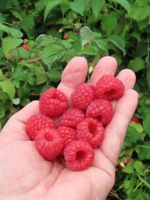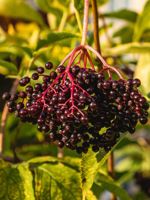Mon-Fri 9am - 5pm Mountain time
Red Mammoth Raspberry vs Bob Gordon Elderberry
Rubus sp. SK Red Mammoth
Sambucus canadensis Bob Gordon
SOLD OUT
Developed by the University of Saskatchewan Fruit Program, SK. Red Mammoth was a high yielding and firm variety released in 1999. It produces distinctively large bright red berries about 1 inch wide. It is also more cold hardy than older raspberry cultivars. Red Mammoth is firm which makes it suitable for commercial production and sweeter than Boyne. Floricane.
Needs to be trellised as canes are not as sturdy as other varieties.
Bob Gordon Elderberry is a Black Elderberry cultivar that produces berries that are larger and sweeter than other varieties, making it one of the top cultivars. It produces large clusters of white flowers that turn into large clusters of dark purple to black berries. The berries are well-suited for baked goods, jams, jellies, and syrups. It was selected from the wild in Missouri.
The large berry clusters that the Bob Gordon Elderberry produces will often end up hanging downward. This makes it more difficult for birds to feed on the berries. If birds are a concern, this might be the right berry for you.
Black Elderberries are considered to be partially self-pollinating. So while they will still produce some berries without cross-pollination, planting with another variety will increase yields. Consider planting with Black Elderberry or Ranch Elderberry.
Warning: the seeds, stems, leaves, roots, and uncooked berries are toxic to humans when eaten in quantity. Berries should be cooked to make them safe for human consumption.
Red Mammoth Raspberry Quick Facts
Bob Gordon Elderberry Quick Facts
Toxicity: leaves, stems, and uncooked berries are poisonous to humans

